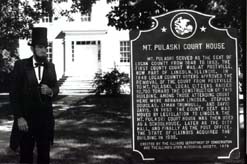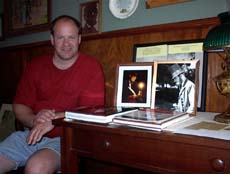|
Mount
Pulaski Courthouse at center of life in town
The
Mount Pulaski Courthouse, where Abraham Lincoln once practiced
law, has always been at the center of life in the town. This
historic site on the city square is one of the only two surviving
Eighth Judicial Circuit courthouses in Illinois. As most of the
residents of Mount Pulaski can tell you, in its second floor
courtroom you can stand on the same floorboards where Lincoln once
stood.
The
citizens are proud of their courthouse and willing to do whatever
it takes to keep it open to the public. In 1992, when state budget
problems caused a cut in staff and the building was closed, the
community decided to take action.
|

[Mount Pulaski courthouse]
|

[The late Harry Hahn of Mount Pulaski,
Abraham Lincoln impersonator who traveled widely in the role of our 16th president, stands in
front of the Mount Pulaski Courthouse.
Picture courtesy of Steve Hahn.]
|
Volunteer
Waneta Stephens remembers when former mayor Larry Montgomery said
he couldn’t sit by and see the main site in Mount Pulaski
closed. He asked for volunteers from the community and got them,
including Mrs. Stephens and her husband, Tom, and Wallace Kautz.
After being closed for seven months, the graceful, two-story Greek
revival building reopened to visitors on Dec. 1, 1992. It has been
staffed by volunteers ever since.
 Today
35 volunteers, who put in about 100 hours a month, keep the
historic Lincoln site open from noon to 5 p.m. Tuesdays through
Saturdays. They guide visitors through the six first-floor offices
of the elected county officials, explaining what kind of business
was conducted in each place. Today
35 volunteers, who put in about 100 hours a month, keep the
historic Lincoln site open from noon to 5 p.m. Tuesdays through
Saturdays. They guide visitors through the six first-floor offices
of the elected county officials, explaining what kind of business
was conducted in each place.
Folks
could register deeds or register to vote in the county clerk’s
office, check on property lines at the surveyor’s office, pay
taxes at the treasurer’s office, conduct legal matters with the
circuit court clerk, learn what was happening in education at the
school commissioner’s office, or check on stray cattle at the
sheriff’s office.
The
offices are furnished with artifacts of the period, although the
furniture is not original to the site. Unfortunately, most legal
documents drawn up while Mount Pulaski was the county seat were
destroyed in an 1857 fire.
The
building was erected in 1848, when Mount Pulaski was the largest
and busiest town in Logan County. The townspeople themselves
raised $2,700 to construct the courthouse, with the state of
Illinois chipping in the final $300. It was a busy site from 1848
until 1855. Waneta Stephens says that when the circuit court was
in session twice a year, the building was so crowded one man
stationed himself in the window of the courtroom and called out
the news as it happened to the crowds on the lawn below.
 In
the 1850s the railroad came to the county, but not to Mount
Pulaski. Lincoln was founded on the railroad line in 1853, and in
another two years county and circuit court business was being
conducted in a new courthouse in the bustling new city. In
the 1850s the railroad came to the county, but not to Mount
Pulaski. Lincoln was founded on the railroad line in 1853, and in
another two years county and circuit court business was being
conducted in a new courthouse in the bustling new city.
The
citizens of Mount Pulaski converted their building into a
schoolhouse. A new school was built in 1878, and the old
courthouse was adapted again, this time for use as city offices.
The basement became a jail. About 1889 it was altered once more to
house the town’s post office, with the second floor serving as a
library and civic center.
Not
until the 1930s was the building recognized as a historic part of
the Lincoln tradition. The town deeded the building to the state
of Illinois, and it was restored to the way it was when Lincoln
practiced law in the second-floor courtroom. The only completely
original part of the building today is the floor in that
courtroom.
The
courthouse site itself conducts three special programs during the
year. An 1890s Open House is set for October 21, with costumed
volunteers, lighted candles, and period music afternoon and
evening. On the first Saturday in December, there is old-time
Christmas music, with cider and coffee. On Lincoln’s birthday,
there is always a speaker.
 When
community events occur, the courthouse also plays a part. At the
Mount Pulaski Fall Festival, scheduled the weekend after Labor
Day, the Women’s Club displays 35 to 50 quilts, both old and
new, in the courthouse. When
community events occur, the courthouse also plays a part. At the
Mount Pulaski Fall Festival, scheduled the weekend after Labor
Day, the Women’s Club displays 35 to 50 quilts, both old and
new, in the courthouse.
At
Christmas on Vinegar Hill, the Saturday before Thanksgiving, 800
to 900 people come to Mount Pulaski for a townwide antique and
craft show. Restaurants and churches serve meals, and the city is
decorated for Christmas. At the courthouse, maps showing event
locations are available, along with music, coffee and hot cider.
Just recently, the grand march for the junior-senior prom was on
the grounds at the courthouse, the lawn crowded with parents and
other relatives.
The
restored building underwent a $250,000 renovation four years ago
and is structurally in good shape, according to site manager
Richard Schachtsiek, so the Mount Pulaski Courthouse State
Historic Site on the city square is ready to take its place in the
lives of the townspeople for many more years.
[Joan
Crabb]
|
Chamber
announces e-commerce workshop
The number of American households on the Internet
grows each day. Many
American businesses large and small are learning that if they want
to communicate with and market to their newly occupied customers,
then they must also have an online presence.
Several Logan County businesses have recognized the
potential of e-commerce and are willing to share their stories
with others.
The Lincoln/Logan County Chamber of Commerce is
sponsoring an e-commerce workshop on Wednesday, May 24.
It will be from 7:30 to 10:30 a.m. in the second floor
conference room of the Union Planters Bank building, located at
the corner of South Kickapoo and Clinton streets. Registration is $10 and payable in advance to the Chamber.
 Mark
Smith, economic development director for Lincoln and Logan County,
says the purpose for the e-commerce workshop is threefold.
First, it will let interested people better understand what
e-commerce is and is not. Next,
website construction professionals will offer tips and advice on
building a website. Finally, local business owners will detail how e-commerce has
and will benefit their bottom line.
There will be ample time for questions. Mark
Smith, economic development director for Lincoln and Logan County,
says the purpose for the e-commerce workshop is threefold.
First, it will let interested people better understand what
e-commerce is and is not. Next,
website construction professionals will offer tips and advice on
building a website. Finally, local business owners will detail how e-commerce has
and will benefit their bottom line.
There will be ample time for questions.
Presenters include local technology professionals Jim
Youngquist from Computer Consulting Associates and Bill Thomas
from Teleologics. Local
business owners who will be sharing their online successes include
Robert and Kay Coons from R & K Sutlery, Lance Rainforth from
Abe’s and Greg Brinner of ReMax/Hometown Realty.
For questions on the workshop or to register, contact
Mark Smith at the Chamber of Commerce, 732-8739 or econdev@lincolnillinois.com.
|
|
|
Mount
Pulaski Historical Society preserves the past
The
people of Mount Pulaski are proud of their heritage. They have
recruited volunteers to keep their historic courthouse site open,
and they have also established a Historical Museum and Research
Center to tell the story of their town and the rest of
southeastern Logan County.
|
|
The
museum, founded by the Mount Pulaski Township Historical Society,
opened in April of 1997 on the west side of the square. It moved
to its new home at 102 Cooke St., on the south side of the square,
in December of 1998.
The
new home is really two buildings: the old Romer building, which
was once a saloon (the town once had 29 of them), and the Danner
building, former home of the First National Bank of Mount Pulaski.
Both buildings were donated by attorneys Thomas and Homer Harris
of Lincoln, who had a law office in the old bank building for 22
years. With a matching grant from the Looking for Lincoln project
and a great deal of volunteer help, the two buildings are being
restored.

The
museum holds memorabilia of all sorts, including a land grant
signed by president Andrew Jackson in 1829, a top hat brought from
England by the Capps family in the 1820s, and a sword used in the
Black Hawk War. Uniforms from the Civil War, World War I and World
War II will soon be on display.

"Lots
of things are coming in all the time from old families in the
area," said Romelda Johnson, the staff member who keeps the
museum open Tuesday through Saturdays from noon to 4 p.m.
|

Memorabilia
from two of the town’s best-known people are in the museum.
Vaughn De Leath, a nationally known singer in the early days of
radio and the composer of hundreds of songs, was born Leonore
Vonderlieth in Mount Pulaski in 1894. She became known as
"The First Lady of Radio" and sang frequently on NBC.

[Steve Hahn, son of the late Lincoln impersonator
Harry Hahn, has donated pictures and other Lincoln memorabilia to
the Mount Pulaski Historical Museum.]
Items
about Lincoln impersonator Harry Hahn, who died in February of
this year, have been contributed by Hahn’s son Steve. Hahn spent
39 years acting the part of Lincoln, traveling all over the United
States and visiting the White House at least twice, according to
his son. The museum exhibits a quilt made by the grade school
children of Mount Pulaski as a memorial to Hahn.
Staff
members like to tell visitors why Mount Pulaski used to be known
as Vinegar Hill. At one time all the towns in the area were
"dry" except Mount Pulaski. It was mainly a German town,
with folks who knew how to hold their liquor and also how to brew
it. People used to come by train from all over – Springfield,
Lincoln, Decatur – to buy liquor. When the conductor asked them
what they were going to put in the jugs they carried, they told
him, "vinegar." So the conductor stopped calling out
"Mount Pulaski" and instead announced they’d come to
"Vinegar Hill."
[ Joan
Crabb]
|
Library
announces summer reading program

The Lincoln
Public Library's summer reading program is again kicking off with
a bang. Children who are planning to read a specified number of
books this summer are encouraged to bring their parents to the
kickoff on Saturday, June 3, from 9 a.m. to noon at the Lincoln
Park District Recreation Center. There will be games, snacks and
the summer reading sign-up until noon. At 9:30 a.m., The Timestep
Players will present the program, "Just for the Fun of
It."
 For more information about
all the great children's programs being offered by the library
this summer, call 732-5732 or stop by the Lincoln Public Library
at 725 Pekin St., across from Latham Park.
For more information about
all the great children's programs being offered by the library
this summer, call 732-5732 or stop by the Lincoln Public Library
at 725 Pekin St., across from Latham Park.
Herb
guild finds thyme to get together
The last Tuesday of each month, a group
of women gather in the Jefferson Street Christian Church to
indulge their senses, greet friends, further their education and
share their passion. The source of all their interest is herbs.
 Since
1994, the Logan County Herb Guild has been meeting and sharing
their love of the same multi-purpose plants their ancestors relied
on hundreds of years ago. They each have a favorite herb –
whether it’s bee balm or basil, sage or thyme, rosemary, tansy,
parsley or maybe mint. They discuss new plants they’ve
discovered are considered herbs, like dianthus and hawthorn. They
pass pots of freshly picked herbs around the room, taking in the
heady scents and discussing their names and uses. They indulge
their taste buds with new recipes using herbs, like rosemary
lemonade, pesto pizza and lavender cookies. Since
1994, the Logan County Herb Guild has been meeting and sharing
their love of the same multi-purpose plants their ancestors relied
on hundreds of years ago. They each have a favorite herb –
whether it’s bee balm or basil, sage or thyme, rosemary, tansy,
parsley or maybe mint. They discuss new plants they’ve
discovered are considered herbs, like dianthus and hawthorn. They
pass pots of freshly picked herbs around the room, taking in the
heady scents and discussing their names and uses. They indulge
their taste buds with new recipes using herbs, like rosemary
lemonade, pesto pizza and lavender cookies.
 Karen
Lowery, a lifelong gardener, founded the guild in 1994. She placed
an ad in the local newspaper, inviting anyone interested in
forming such a group to attend a meeting. To her surprise, about
30 women showed up. The informal group has been meeting ever
since, first at each other’s homes and now at the church. Karen
Lowery, a lifelong gardener, founded the guild in 1994. She placed
an ad in the local newspaper, inviting anyone interested in
forming such a group to attend a meeting. To her surprise, about
30 women showed up. The informal group has been meeting ever
since, first at each other’s homes and now at the church.
“We’ve had a lot of neat programs
over the years. It’s been fun, that’s the main thing. If you
can make a club fun, with little work, that’s the key,” she
said.
Lowery, who is also a member of the
newly formed Mount Pulaski Herb Guild, said the local interest in
herb gardening is really increasing.
“I think there’s a real interest in
gardening. Interest is always picking up. We have a lot of members
that just come about every third meeting. I think once people get
hooked in herb gardening, they find out how relaxing it is and how
they feel when they use them instead of salt or sugar. It’s good
for the mind and body both,” she said.
 At
a recent guild meeting, Lowery, dressed in period costume as a
pioneer woman, gave a rousing talk about the history of herbs and
what plants our ancestors brought from their homelands and how
they used them. Even though she has been gardening all her life,
her enthusiasm and interest in herb gardening is refreshing and
contagious. At
a recent guild meeting, Lowery, dressed in period costume as a
pioneer woman, gave a rousing talk about the history of herbs and
what plants our ancestors brought from their homelands and how
they used them. Even though she has been gardening all her life,
her enthusiasm and interest in herb gardening is refreshing and
contagious.
Lowery said
the guild is not only an educational experience but something all
ages can enjoy.
“We have members in their 20s and 90s, a wide span of
ages, and when we have our meetings, there’s no generation gap.
That’s the neat thing about plants and herbs, it bridges all
generations,” Lowery said.
“I like the historical aspect of
herbs. Our forefathers were pretty savvy about plants. We got away
from our roots, but we’re starting to get back to it. Like
coneflowers, which people use and grow now, the Native Americans
used – good benefits,” she added.
Lowery, who confesses to planting “tons
of things,” has about 60 different varieties of herbs, including
an abundance of the sweet-smelling though very invasive lemon
balm, but has a special affection for bee balm, or monarda, and
English thyme. Her herbs are contained in six 10-by-3-foot plots,
a large 100-square-foot garden, along the house, in the pasture
and just about any place there is a bare patch of dirt around her
rural Beason home. Wildflowers are tossed into the gardens to give
an added boost of color to the herbs.
 The
herb guild, which now has 22 official members, meets the last
Tuesday of each month at the Jefferson Street Christian Church.
Dues are $12 a year, which cover the cost of a monthly newsletter.
The public is invited and usually an average of 30 people attend
the meetings. The
herb guild, which now has 22 official members, meets the last
Tuesday of each month at the Jefferson Street Christian Church.
Dues are $12 a year, which cover the cost of a monthly newsletter.
The public is invited and usually an average of 30 people attend
the meetings.
Guest speakers often give programs on
topics such as cooking with herbs, making herbal vinegars, crafts,
dried flower arranging and beneficial bugs for the garden. The
group also travels to Clark’s Greenhouse in rural San Jose for
their May meeting, which includes a plant swap and tour of the
business. Some years the group holds a summer garden walk and tour
of several members’ gardens. The guild also sponsors a couple of
trophies at the Logan County Fair, has given the Herb Companion
magazine to the local library and demonstrates uses for herbs at
the annual Railsplitter Festival.
“We try to get out a little bit in
the community,” she said.
Lowery, who said her grandmother
sparked her interest in gardening when she was a small child,
holds a zoology degree and teaches biology and four environmental
science classes at Bloomington High School. In between teaching
and chauffeuring her 13-year-old son to sports events and
practices, she tends to her wildflowers, herbs, perennials and a
few vegetables at her rural home and also gives lectures and
programs at local nurseries and other events.
“I
use herbs for culinary purposes and also use a few medicinal. I’ve
always had an interest in herbs. It started with my interest in
cooking. I also love the way they smell,” she said. She favors
thyme, which can be used as a ground cover, for its tiny flowering
habit and scent, and
basil. Her other favorites include chives, parsley and
cilantro. “I also
used them for ornamental uses. Even now, I have a small bouquet of
purple
chive flowers on my dining room table,” she said.
 “I’ve enjoyed meeting other people
who share my interests in herbs and gardening. We’ve all learned
together. We talk about how at our first plant exchange, we didn’t
have much stuff and how different it is now, how much more we all
have to exchange and how much we’ve learned. It’s fun to see
how we’ve grown together,” she said. “I’ve enjoyed meeting other people
who share my interests in herbs and gardening. We’ve all learned
together. We talk about how at our first plant exchange, we didn’t
have much stuff and how different it is now, how much more we all
have to exchange and how much we’ve learned. It’s fun to see
how we’ve grown together,” she said.
The herb guild will sponsor its first
annual plant sale, which is their yearly fund-raiser, from 8 a.m.
to noon, May 20, at Cooper’s home, at 140 Campus View Drive.
More information about the guild or its programs may be obtained
by calling her at 732-9788.
[Penny
Zimmerman-Wills]
|
Annual
bird count logs beautiful birds
“Is
that a beautiful bird, or what?” The beautiful bird, an
indigo bunting, continued catching insects in the grass, giving
the 18 bird-watchers a chance to focus their binoculars and see
its feathers glimmering iridescent blue in the sun.
 The small, brown bird feeding nearby was not so cooperative.
He flew away before anyone could get a positive
identification. The small, brown bird feeding nearby was not so cooperative.
He flew away before anyone could get a positive
identification.
“I
think it was a Savannah sparrow, but I can’t be sure,” leader
Steve Coogan said. “We’ll
have to log it as a ‘question-mark’ sparrow.”
The
birders who met in Kickapoo Creek Park at 7 a.m. Saturday were
able to positively identify another 31 species, along with brief
sightings of a “question-mark” thrush and a couple of “question-mark”
warblers. Coogan, an
ardent naturalist who lives in Latham, added the 32 species to the
five other migrating warblers he had seen earlier at Skunk Hollow.
These birds, and the ones he would see later that day,
would be reported to the Illinois Department of Natural Resources,
Division of Natural Heritage, as part of the annual spring bird
count.
The
bird count helps state naturalists keep track of the species
moving through on migration as well as those birds coming back to
this area to nest.
 This
year both the number of participants and the number of species
identified were lower than usual.
“We usually see about 50 species and have about 35 people
present,” Coogan said. This
year both the number of participants and the number of species
identified were lower than usual.
“We usually see about 50 species and have about 35 people
present,” Coogan said.
Coogan
thought the decrease in the number of species was because of the
early warm weather. Many
migrating birds are insectivores, and if flowers and trees bloom
early, insects and the birds who eat them arrive – and move on
– early, too. In
addition, Coogan said, trees have already leafed out, making birds
harder to spot.
With
this in mind, Coogan set next year’s official bird count day as
the last Saturday in April. The day was not a disappointment
to the birders, though, who ranged in age from 9-year-old Benjamin
Conrady to senior citizens.
 A
handsome gray catbird sat on a low limb and serenaded the group
with a series of tweets, whistles and warbles, ending with a
raucous screech that some people think sounds like a cat.
The bird is a mimic, like its cousin the mockingbird, which
is now occasionally seen in the Lincoln area. A
handsome gray catbird sat on a low limb and serenaded the group
with a series of tweets, whistles and warbles, ending with a
raucous screech that some people think sounds like a cat.
The bird is a mimic, like its cousin the mockingbird, which
is now occasionally seen in the Lincoln area.
A
phoebe was seen building a nest, mostly of mud, on a rafter under
a shelter. Canada
geese protested the birders’ approach to the creek where the
geese were swimming, perhaps looking for a nest site.
Something
small and twittery caught the attention of a sharp-eyed birder,
and half a dozen others thought it was worth wading through poison
ivy to see the black-throated green warbler he’d spotted.
The warbler sat in a small tree preening its feathers,
providing an excellent view of a bird that would not be back until
the fall migration.
“I’ve
never seen a warbler so cooperative,” Coogan said. “This is a gift.”
In
the open area of the park, meadowlarks sang and an eastern
kingbird sat on a small tree, ignoring the birders and
occasionally diving down into the grass or swooping through the
air to catch an insect.
“That
bird is one of the tyrant flycatchers,” Coogan said. “They can be mean birds.
I’ve seen them mob hawks.”
Donna
Hellman, wife of park ranger Don Hellman, said she knew all about
those mean birds. “Last
year we had a pair nesting at the edge of our property.
When I mowed I had to wear a hard hat because they would
dive-bomb me.”
 The
birder everyone agreed had the sharpest eyes, Mark Tebrugge,
spotted a medium-sized, bright yellow bird in the top of a
sycamore. Everyone
agreed it was an oriole, but the question was what kind?
Field guides came out of pockets and backpacks. The bird
was yellow, not orange, so it ought to be a female.
But it was singing, which made it more likely to be a male.
Then the bird turned, displayed its black bib, and the
puzzle was solved. It
was an immature male orchard oriole, which will turn russet red
next year. The
birder everyone agreed had the sharpest eyes, Mark Tebrugge,
spotted a medium-sized, bright yellow bird in the top of a
sycamore. Everyone
agreed it was an oriole, but the question was what kind?
Field guides came out of pockets and backpacks. The bird
was yellow, not orange, so it ought to be a female.
But it was singing, which made it more likely to be a male.
Then the bird turned, displayed its black bib, and the
puzzle was solved. It
was an immature male orchard oriole, which will turn russet red
next year.
It was
a beautiful bird.
[Joan
Crabb]
|
American
Red Cross classes offered in May
Upcoming
American Red Cross classes will be offered at the Logan County
office at 125 S. Kickapoo St. in Lincoln.
A
Community First Aid and Safety class will be Wednesday, May 17,
from 6 to 10 p.m. and Thursday, May 18, from 5 to 10 p.m. The
class will cover adult CPR, child and infant CPR and first aid.
A
Challenge class will be Saturday, May 20, from 9 a.m. to noon.
People who have previously been certified in the above classes may
demonstrate their skills and be recertified.
Preregistration
is required. For further information, call 732-2134 between noon
and 4 p.m. any weekday.
|
ALMH
accepts applications for summer teen volunteers
Applications
are currently being accepted for this summer’s teen volunteer
program at Abraham Lincoln Memorial Hospital.
Teen
volunteers work throughout the hospital, performing a variety of
duties in many different departments. To be eligible for the
program, teens must be an eighth grade graduate and must complete
an application form that includes personal references. All teen
volunteers must also complete the training session scheduled on
Friday, June 9, from 9 a.m. to noon at the hospital.
Applications
are available at ALMH from Barbara Dahm, director of volunteer and
special services. Applications should be filled out and returned
in person to the volunteer office as soon as possible. A brief
interview will be conducted at that time. For more information,
call 217-732-2161, ext. 184.
|
|
Atlanta
4-H club invites youth from town to join
The
members of the Atlanta Town and Country 4-H club invite eligible
youth from town to join. Jeff Jones, the club reporter, says,
"4-H isn’t just for people who live in the country. There
are lots of things for a guy or a girl from town to do."
Activities include cooking, growing flowers, woodworking, small
engines, arts, crafts and herb gardening. For more information,
people can call 217-648-2973.
|
|